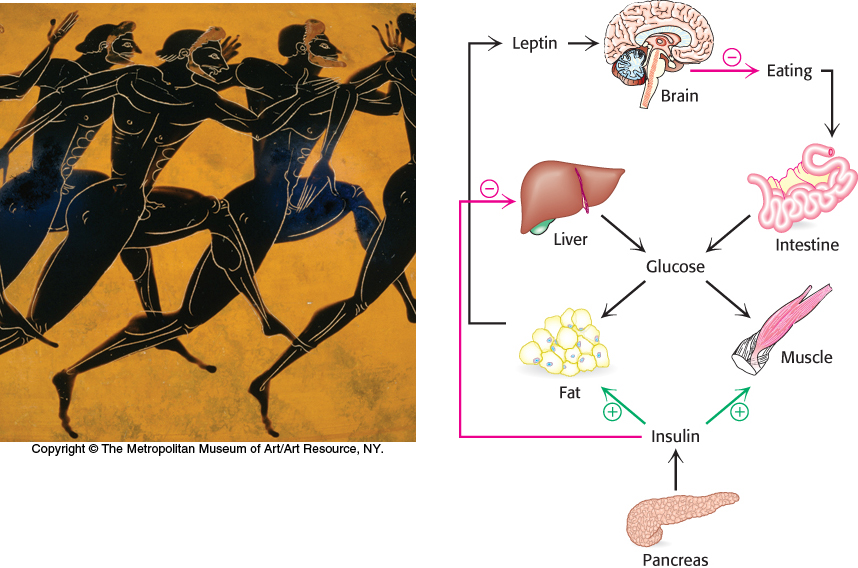Chapter Introduction
The Integration of Metabolism

The image above to the left shows a detail of runners on a Greek amphora painted in the sixth century B.C. Athletic feats, as well as others as seemingly simple as the maintenance of blood-glucose levels, require elaborate metabolic integration. The representation at the right shows the organs that have essential roles in the metabolic integration that regulates blood-glucose levels during exercise and at rest. Insulin and leptin (secreted by adipocytes) are two of the hormones that modulate the metabolic pathways of organs throughout the body such that adequate energy is available to meet the demands of living.
OUTLINE
Caloric Homeostasis Is a Means of Regulating Body Weight
The Brain Plays a Key Role in Caloric Homeostasis
Diabetes Is a Common Metabolic Disease Often Resulting from Obesity
Exercise Beneficially Alters the Biochemistry of Cells
Food Intake and Starvation Induce Metabolic Changes
Ethanol Alters Energy Metabolism in the Liver
We have been examining the biochemistry of metabolism one pathway at a time. We have seen how useful energy is extracted from fuels and used to power biosynthetic reactions and signal-transduction pathways. In Chapters 28 through 30, we will extend our study of biosynthetic reactions to the synthesis of nucleic acids and proteins. Before we do that, however, in this chapter we will take a step back to examine large-scale biochemical interactions that constitute the physiology of the organism. In keeping with a central theme of life—energy manipulations—we will look at the regulation of energy at the organismal level, which boils down to an apparently simple but actually quite complex question: At the biochemical level, how does an organism know when to eat and when to refrain from eating? The ability to maintain adequate but not excessive energy stores is called caloric homeostasis or energy homeostasis.
Next, we will examine a significant perturbation of caloric homeostasis—obesity—and how this physiological condition affects insulin action, frequently resulting in diabetes. We then turn our attention to a biochemical consideration of one of the most beneficial activities that humans can engage in—exercise—and see how exercise mitigates the effects of diabetes as well as how different forms of exercise use different sources of fuel.
At the opposite end of the physiological spectrum from obesity and overnutrition are fasting and starvation, and we will examine the biochemical responses to these challenges. The chapter ends with a consideration of another biochemical energy perturbation—excess alcohol consumption.
We have already encountered instances of organismal energy regulation when we considered the actions of insulin and glucagon. Recall that insulin, secreted by the β cells of the pancreas, causes glucose to be removed from the blood and stimulates the synthesis of glycogen and lipids. Glucagon, secreted by the α cells of the pancreas, has effects opposite those of insulin. Glucagon increases the level of blood glucose by stimulating glycogen breakdown and gluconeogenesis. This chapter introduces two other hormones that play key roles in caloric homeostasis. Leptin and adiponectin, secreted by the adipose tissue, work in concert with insulin to regulate caloric homeostasis.
